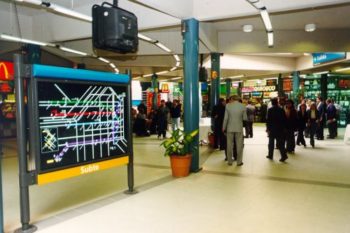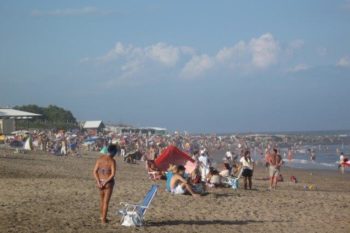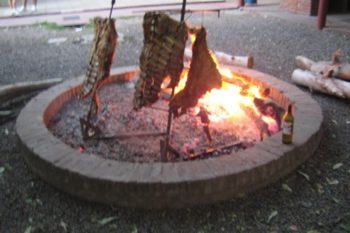Porteños, as locals are called, like to get together with friends to have leisurely discussions ranging from the whys and wherefores of life to their beloved football team, the course of the economy (always in some sort of crisis or another), or their amorous escapades in excruciating detail (they are, after all, of Latin descent, and, let’s face it, men like bragging).
Cafes are not only a rendezvous for friends: job interviews and work-related meetings also take place in them. Even love affairs begin and end over steaming cappuccinos.
Cafes are quite busy early in the morning, when office workers stop by for a breakfast of the national combo: “cafe con leche y medialunas” (white coffee with croissants) or a “tostado mixto” (a ham and cheese toasty). The morning paper is usually provided as well. It can safely be said that a cafe is an extension of home and office.
Cafes play such a key role in popular culture too that even songs have been dedicated to them, especially tangos. Twenty years or so ago, there was a hugely popular and long-running TV show about a group of friends that met in a cafe every week. Does it ring any bells?
Thanks to the influence of Italian immigrants at the turn of the 20th century coffee is always espresso; filter coffee is sacrilege in these latitudes. A very few places offer “cafe americano,” as filter coffee is called here, but it doesn’t seem to be very popular. It is served in “pocillos” (demitasses) or “jarritos” (stemmed glass cups with a handle.)
Patrons can choose between “café,” “café doble” (a large coffee), “café con crema” (coffee with a dollop of whipped cream), “cortado” (three quarters coffee, a quarter milk), “lágrima” (a quarter coffee, three quarters milk), “capuchino” (coffee, a drop or two of milk, milk froth) and “cafe con leche” (cafe au lait.) The price generally includes a small glass of soda water (maybe orange juice in more upscale places) and a small sweet treat, like a cookie.
The social and cultural influence of cafes is such that fifty-three of the oldest establishments have been declared part of the cultural and historical heritage of the city of Buenos Aires. Many of them were founded by Italian and Spanish immigrants in the early 20th century. Cafe Tortoni (Avenida de Mayo 825), perhaps the most popular with tourists; and Confiteria Ideal (Suipacha 384) are just two of them.
Wood panelling, brass fixtures, marble tops, and tango music playing softly in the background conspire to take one back to a bygone era when artists, writers, musicians and intellectuals met to discuss ideas over (what else?) endless cups of this sexy dark beverage.
A warm welcome to Ana, who is going to be writing about Argentinian culture on PocketCultures. Ana was born and raised in Argentina, and she keeps close links with her country, despite being currently based abroad. You can read more about Ana’s experiences living abroad on her blog.
Read more:
Italian cafe culture: when to drink cappuccino
Submarino: another Buenos Aires classic
Argentinian blogs on Blogs of the World







It’s so interesting to see the mix of influences in the coffee culture – cortado like in Spain, cappuccino / capuchino like in Italy. Nice post!
I really enjoyed your post!
I love the cafe cultures of Europe, and even in my native Holland people love to linger on outdoor terraces, coat on if necessary.
Except in big cities, it’s not really part of life in the US where I’m parked for the moment, and I really miss it. Life here is too fast and frantic.
Your post makes me want to live in Argentina. I’d be at home there, drinking my coffee!
Thank you Liz and Miss Footloose for your comments!
Very good article, Ana! …now I am craving white coffee and croissants…
It’s so interesting that some of the cafes have been called historical and cultural landmarks. Now I’m hungry for croissants…thanks. 🙂
Makes me want to grab my book and head over to the coffee shop for an all afternoon treat!
Great post Ana….Loving your descriptions. Makes me feel like Im there !!!
Thanks Ana. Brought back many happy memories and
only wish we could join you again!
Muy bueno Ani, mañana me voy a desayunar a un cafecito una lágrima doble con unas buenas medialunas rellenas!!!!!!!!!!!!!!!!!!!!
well done ana, i really enjoyed reading your blog. you have a wonderful way with words
can’t wait to read some more
I think I would do much better work if I could do it in a cafe with a cafe con crema! I should submit this article to my boss…. 🙂
great post! i absolutely love coffee. hopefully someday, i get to have one in argentina 😀
I’d like to thank everyone for all the encouraging comments. Gracias!
Our coffee culture runs so deep in Argentina (and Buenos Aires in particular), that one of the things I always want to do when I travel back home is to have a cafe con leche at one of the true old cafes. Trouble is that with so many friends to visit and family members who want to spend time with me, I NEVER GET TO DO IT. So I always say . . . next time. After all I know that those old cafes will be there ready to greet me!
Wonderful post! The cafe con leche and medialunas look delicious. You might also like to check out our recent post (from Vicky Baker) about cafe culture in Buenos Aires, Argentina. http://www.therealargentina.com/argentinas-cafe-culture/
Thanks for stopping by, Argento!